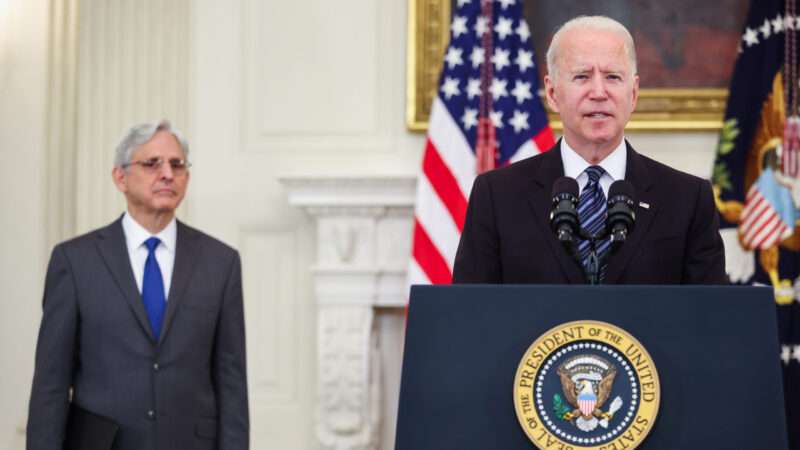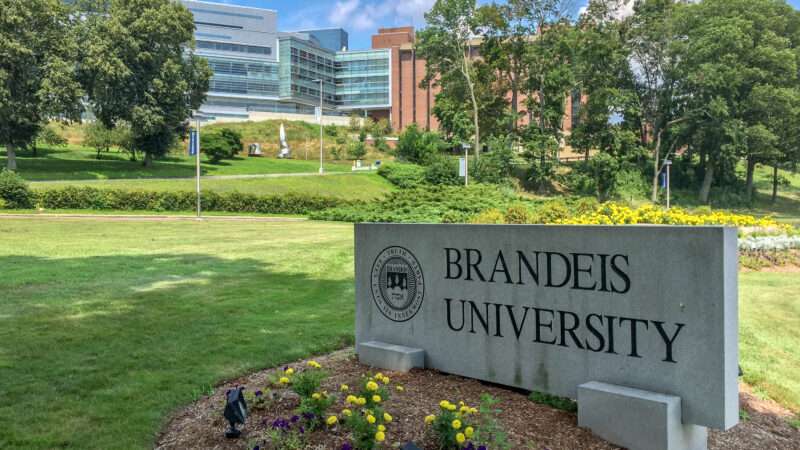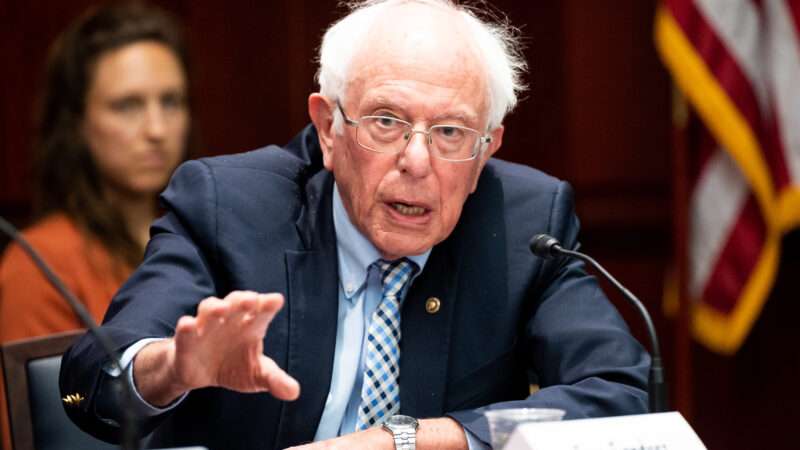
The anti-crime agenda that President Joe Biden announced yesterday is heavy on gun control measures that cannot reasonably be expected to have a substantial impact on surging homicide rates. In particular, the benefits of cracking down on “rogue gun dealers” are bound to be slight, since only a small percentage of criminals buy firearms from federally licensed retailers.
Under the Biden administration’s new “zero tolerance” policy, gun dealers who “willfully” violate federal law will automatically lose their licenses “absent extraordinary circumstances.” That includes dealers who “willfully violate the law by failing to conduct required background checks, falsifying records, failing to respond to trace requests, refusing to permit ATF [the Bureau of Alcohol, Tobacco, Firearms, and Explosives] to conduct inspections, or transferring firearms to persons who are prohibited from owning them.”
One glaring problem with that plan: According to a 2019 report from the Bureau of Justice Statistics (BJS), just 7 percent of criminals who use guns buy them “under their own name from a licensed firearm dealer.” Furthermore, such transactions are legal as long as the buyer is not disqualified from owning guns. A licensed dealer who sells a gun to someone who does not yet have a felony record, even if that person later uses the gun to commit a crime, is not violating federal law, let alone doing so “willfully.”
A dealer is violating federal law if he fails to conduct a background check or if he knowingly sells a firearm to someone who is legally disqualified. But even assuming the Biden administration’s new policy deters the “rogue gun dealers” who deliberately sell firearms to illegal buyers, people with felony records can always enlist people with clean records to buy guns for them. While such straw purchases are illegal, the dealer is willfully violating the law only if he knows that the buyer is acting on behalf of someone else.
In any event, the “zero tolerance” initiative will have no impact at all on the vast majority of guns used in crimes—something like 93 percent, according to the BJS study, which was based on a 2016 survey of prison inmates. The survey found that 43 percent of inmates who had used a gun obtained it “off the street or from the underground market,” 25 percent got it “from a family member or friend, or as a gift,” 7 percent “found it at the scene of the crime,” and 6 percent stole it.
The Biden administration plans to attack the underground market through “multijurisdictional firearms trafficking strike forces.” That attempt to prevent illegal gun sales probably will be about as effective as the government’s efforts to prevent illegal drug sales. With hundreds of millions of guns already in circulation, there will be far more than enough to supply every criminal in America even if the feds manage to snatch a few of them.
Biden wants to “strengthen our gun background check system” by expanding it to cover private sales, which would require new legislation. Needless to say, underground dealers who specialize in serving illegal gun buyers are unlikely to follow that requirement. So are millions of otherwise law-abiding Americans who simply want to sell a gun or two without the hassle and expense of going through a licensed dealer so a background check can be completed. The experience of states that already notionally require background checks for all gun transfers suggests that compliance would be the exception rather than the rule.
Biden claims “we know that if there is a strict enforcement of background checks, then fewer guns get into the hands of criminals.” Based on blocked purchases, he says background checks “have thus far kept more than 3 million guns out of the hands of…convicted felons, fugitives, domestic abusers, and others prohibited from being able to purchase a gun.” But the categories of prohibited gun buyers are absurdly broad, encompassing millions of Americans who have never demonstrated any violent tendencies. And judging from what typically happens after a purchase is blocked, few rejected buyers pose serious threats to public safety.
According to a 2018 report from the Government Accountability Office (GAO), background checks “resulted in about 112,000 denied transactions in fiscal year 2017.” Someone who tries to buy a gun even though he knows he is not legally allowed to own one is attempting a felony. If he lies on the ATF form that people have to fill out when they buy guns from federally licensed dealers, that’s another felony. But in fiscal year 2017, the GAO reported, the ATF thought just 12,700 of those 112,000 blocked buyers were worth investigating, and U.S. attorney’s offices had prosecuted only 12 of them as of June 2018. Justice Department officials told the GAO “prosecuting denial cases can require significant effort and may offer little value to public safety compared to other cases involving gun violence” (emphasis added).
A 2004 report from the Justice Department’s inspector general sheds further light on the sort of gun buyers who are typically flagged by background checks. If the FBI cannot complete a background check within three business days, the dealer is allowed to complete the sale, so the ATF is sometimes tasked with seizing guns after the fact from people who are not legally allowed to own them. The inspector general noted that there were often delays in retrieving weapons from prohibited buyers, partly because “ATF special agents did not consider most of the prohibited persons who had obtained guns to be dangerous and therefore did not consider it a priority to retrieve the firearm promptly” (emphasis added).
Presumably some would-be gun buyers who fail background checks plan to use the weapon for criminal purposes. But contrary to what Biden seems to think, stopping someone from buying a firearm at a gun store is not the same as preventing him from obtaining one, as the data on sources of crime guns demonstrate.
The “assault weapon” ban that Biden once again urged Congress to pass is even less plausible as a response to rising homicides. The firearms covered by such laws account for a tiny fraction of the guns used in homicides, and there are plenty of equally lethal alternatives, as Biden himself has conceded.
Biden also mentioned banning “high-capacity magazines,” meaning magazines that hold more than 10 rounds, which come standard with many of the most popular handguns and rifles sold in the United States. He obscured that point by saying “there’s no possible justification for having 100 rounds in a magazine.” In practice, the real issue is whether standard-capacity magazines holding, say, 12, 15, or 20 rounds are useful in some self-defense situations. The current and retired police officers who always insist that they be exempt from state restrictions on magazine capacity certainly seem to think so.
Biden is not even willing to acknowledge that the Second Amendment has anything to do with self-defense. “No one needs to have a weapon that can fire over 30, 40, 50, even up to 100 rounds unless you think the deer are wearing Kevlar vests or something,” he said. Biden thought that comment was so clever that he repeated it: “Like I’ve said before: What do you think, the deer are wearing Kevlar vests?”
Biden’s lame joke is of a piece with his previous remarks about legitimate gun use, which suggest he thinks the Second Amendment is mainly about hunting rather than the fundamental right to armed self-defense. That misconception makes it hard to give him the benefit of the doubt when he touts new gun controls that have little or nothing to do with the problems he claims to be addressing.
from Latest – Reason.com https://ift.tt/2UCMjgv
via IFTTT




